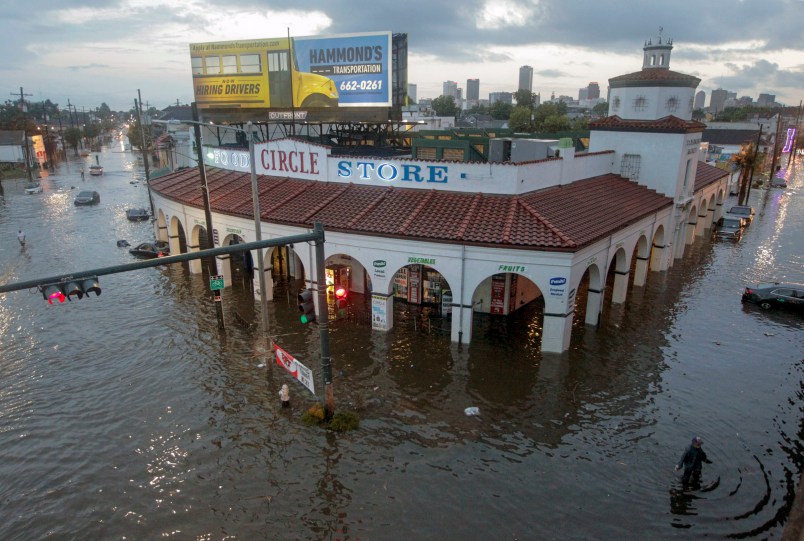NEW ORLEANS (AP) — Louisiana’s governor declared a state of emergency in New Orleans on Thursday as the city’s malfunctioning water-pumping system and the threat of more rain left some neighborhoods at greater risk of flooding.
The city scrambled to repair fire-damaged equipment at a power plant and shore up its drainage system, less than a week after a flash flood from torrential rain overwhelmed the city’s pumping system and inundated many neighborhoods.
Gov. John Bel Edwards described his emergency declaration as a precautionary measure. He and Mayor Mitch Landrieu tried to calm the jangled nerves of residents still angry about the city’s response to last weekend’s flooding.
“Obviously this is a serious situation, but it’s not something to be panicked about,” Edwards said at a City Hall news conference.
Landrieu urged residents of some waterlogged neighborhoods to prepare for another possible round of flooding by moving vehicles to higher ground. All of the city’s public schools were closed Thursday and were scheduled to be closed again on Friday.
Jamie Hill, a resident of the Mid-City neighborhood that has flooded twice in the past month, was clearing mud, sand, grass and other debris from the storm drain near her home. Her car flooded in an earlier downpour a few weeks ago. She said she’s learned her lesson and now moves her car anytime it rains.
“I’m doing what I can, not that it will really matter if the pumps aren’t working,” she said.
New Orleans’ municipal pumping system is supposed to move water out of the low-lying city. Having the system crippled in August could not come at a worse time for New Orleans, since the Gulf Coast is in the middle of hurricane season.
But officials feared that even a common thunderstorm would test the system’s reduced capacity.
“With great prayer and a lot of hard work, hopefully we’ll be OK,” the mayor said.
Landrieu’s office said in a news release early Thursday the city has lost service to one of its turbines, which powers most of the pumping stations that service the East Bank of New Orleans. Landrieu said that means the system’s capacity to drain storm water from the streets has been diminished.
“It was an internal fire within the turbine itself, and it was a critical part,” Landrieu said
The mayor said the city is bringing in generators to back up the system and hoped to have them installed within 48 hours. Earlier, Landrieu said the power available early Thursday wouldn’t be adequate to protect the city from another massive rainfall.
National Weather Service meteorologist Phil Grigsby said scattered thunderstorms and showers were in the daily forecast for the region through the weekend and into next week. But he called that a “fairly normal (weather) pattern” for south Louisiana in August.
“We can get a quick band of 1 to 2 inches (2.5 to 5 centimeters) of rain in an hour. Normally (the pumps) can handle that,” Grigsby said. “But with the reduced capacity, it’s something we have to keep an eye on.”
Earlier this week, city officials and spokespeople had said repeatedly that all 24 pumping stations were working at full capacity.
But after the system failed to keep up with a storm that dropped 9.4 inches (24 centimeters) of rain in three hours, the truth about the state of the water pumps began to emerge.
Despite what the public had been led to believe, city council members were then told that pumping stations in two of the hardest-hit areas went down to half- to two-thirds capacity on Saturday, news outlets reported.
“It is unacceptable that the public was not only uninformed, but misinformed as to our drainage system functionality during the flood,” Council Member LaToya Cantrell said in a statement Wednesday.
Cedric Grant, one of Mayor Mitch Landrieu’s top deputies and the head of the Sewerage & Water Board, told the city council Tuesday that he would retire at the end of hurricane season, which lasts through November.
Public Works Director Mark Jernigan submitted his resignation shortly after the council meeting, when he was asked whether his agency had done enough to clean the catch basins that feed the drainage system.
Landrieu said he also wanted the board to fire Joseph Becker, the Sewerage & Water Board’s general superintendent.







Used to live in New Orleans. Hope things turn out ok.
Concern emanates from the White House:
Daddy Wun Dum Fuk: *"I’m glad I never built a tower there. The place is a real dump, a drug-infested den.
How are my golf courses in Florida? Are they still over-insured?"
Ivankatoinette (channeling Babs Bush): "I think things are working out very well for them.
It’s a good thing I sell Signature raincoats."
BTW: Gov. John Bel Edwards, a Democrat, can likely expect doodly-squat from FEMA.
Wow Republican presidents are a really bad omen for New Orleans!
Trump hasn’t appointed a new head to FEMA. Its still being run by Fugate, who Obama appointed. So yeah, its doubtful that FEMA is on anybody’s radar in the WH.
The new head of FEMA is Brock Long. Oddly enough, he’s one of the few (only?) appointees that actually has experience in his field, as opposed to a major/minor in grifting.